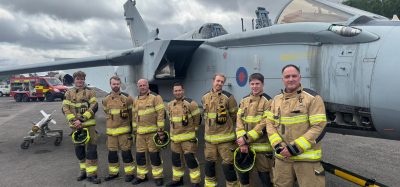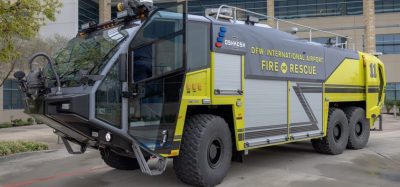Cargo Aircraft: Planning is Paramount
Posted: 28 September 2007 | Bob Lindstrom Jr., Chairman ARFF Working Group | No comments yet
In Aviation Fire Protection we arrive at work daily and think about all the possible scenarios we might be up against. There is a mindset we have to use to see how our training and planning can fit into any scenario. Each day I come to work and think about my role in any given incident. I look at the weather forecast, the other conditions such as runway and taxiway closures, vehicle status of our ARFF (Aircraft Rescue Fire Fighting) vehicles and personnel status. Then throw in some problems with the roads connecting to our airport and we already have a list of things to think about before we even have a problem. In our industry I’d like to say that we plan for the worst and hope for the best. Sounds a bit cliché but if we did not look at things like this, then we stand the chance of coming up short.
In Aviation Fire Protection we arrive at work daily and think about all the possible scenarios we might be up against. There is a mindset we have to use to see how our training and planning can fit into any scenario. Each day I come to work and think about my role in any given incident. I look at the weather forecast, the other conditions such as runway and taxiway closures, vehicle status of our ARFF (Aircraft Rescue Fire Fighting) vehicles and personnel status. Then throw in some problems with the roads connecting to our airport and we already have a list of things to think about before we even have a problem. In our industry I’d like to say that we plan for the worst and hope for the best. Sounds a bit cliché but if we did not look at things like this, then we stand the chance of coming up short.
I think back to all the aviation accidents since I’ve been involved in ARFF and the most memorable was the Sioux City, Iowa accident. Those fire fighters all went to work that morning thinking of those very same things I mentioned above, but did they really think they would have an accident of that magnitude drop into their airport? I don’t think they did in their wildest dreams. This incident had all of us associated with ARFF thinking about ‘The Big One’.
One potential incident, out there waiting to happen, could involve a cargo aircraft. The air cargo aircraft are becoming a major player in most airports. Some of these aircraft are as small as a Cessna Caravan, but could be as large as a Boeing 747, or even the new Airbus A380 in the very near future. So, what are the differences between planning for a cargo aircraft and a passenger aircraft? Honestly not very much, but we do have a lot of unknowns that we do not have with passenger aircraft.
In a passenger aircraft we can be fairly confident that we will not have hazardous cargo on board. I say fairly because we all know some things have made it on to aircraft in the past, but with today’s security measures the chances have lessened. Cargo aircraft, on the other hand, can contain things that have been marked incorrectly by the sender and could contain hazardous materials. There could also be items which are not marked that have chemical properties which, when mixed with something else, can start a fire. I personally have responded to a few incidents on cargo aircraft where someone has not marked a package properly and this has resulted in a hazardous materials emergency. This problem is out there waiting to happen on any given flight.
There is another industry wide issue involving cargo aircraft. How about the protection of the aircrew? It is a known fact that there are cargo aircraft landing at airports with Category 2 ARFF protection levels, yet the aircraft requires Category 7 protection. There might only be enough agents to protect half of the spill fire potential area and the fact you might only have one or two fire fighters. So what is being done about the protection of the aircrews? Currently in the United States there are no rules requiring any ARFF protection for cargo aircraft. Of course this does not mean that we are ignoring the issue, but airports have to evaluate the risks and plan properly.
The types of incidents that occur on cargo aircraft are really no different to those of passenger aircraft. The one major difference is how we can attack the fires. In a passenger aircraft we have passengers whom will mostly self egress in most situations. These fires tend to spread rapidly and make rescues more difficult depending on the condition of the aircraft and the circumstances which caused the aircraft to catch fire. An example would be a crashed aircraft which had an electrical fire in the overhead area in the passenger compartment.
In cargo aircraft we are dealing with fewer occupants, but the cargo is usually loaded tightly to use all space available to save money and maximise the use of the cargo space. The cargo can be palletised or in cargo containers (cans as we call them). This loading also takes into consideration the weights and balances of the aircraft, which may cause voids in the spacing. Attacking the cargo fires can be very hard due to this configuration.
Simply put, you have to go back to the basic principle of putting out a fire. You have to apply the extinguishing agent to the base of the fire, but getting to the base of the fire can be the greatest challenge. One such incident was the UPS DC-8 fire in Philadelphia a couple of years ago. This aircraft developed an in-flight fire and requested an emergency landing at the Philadelphia airport. When the ARFF crews arrived they had smoke showing, but fortunately the flight crew managed to escape from the aircraft successfully. The difficulty was gaining access to the seat of the fire and this part consumed a lot of time and water before the fire was extinguished.
Cargo aircraft, like any other aircraft, can crash. There have been a few of these incidents in the past few years. One that comes to mind is the FEDEX MD-11 incident in Memphis Tennessee July 28th, 2006. This was a good example of a low impact crash which occurred due to landing gear failure. The aircraft came to rest with a large spill fire located on the left side wing area of the aircraft. The quick action from the ARFF crews at Memphis ensured that the fire was quickly extinguished and loss was contained to the aircraft itself.
Memphis of course is the home base to FEDEX and they work closely with the City of Memphis Fire Department to combine forces and protect the aircraft and crews. Both have an ARFF Department with High Reach Extendible Turrets (HERT) installed on ARFF vehicles. These devices get the agent closer to the fire while giving the operators a better visual of the fire attack. They are also equipped with penetrating nozzles allowing the agent to be pierced into the skin of the aircraft and applied.
No matter what, you have to provide protection for your cargo aircraft and the best defence is a good offence. Look at your risks, the size of the aircraft will tell you the fire risk and the crew size will help you to understand the rescue aspects of the situation. You will also want to review the ARFF capabilities of your Fire Department. Look to the National Fire Protection Association (NFPA) Standards for ARFF requirements for the specific size Aircraft you are protecting.
Each situation is different. Some of the equipment and situations I have discussed in this article only scratch the surface of what you may encounter. Be proactive and assess your airport and make sure that your ARFF Department is trained on all aspects of dealing with a cargo aircraft fire. Have lesson plans that will provide general guidance and written standards which will guide the incident commander and personnel towards a goal of saving lives and protecting property. Attend training at facilities which can give your fire fighters hands on experience of dealing with the problems of fighting a cargo aircraft fire. Also involve your whole airport in the education process for dealing with Cargo aircraft. So far I’ve only spoken of civil aviation aircraft; there is also the fact that we have several military cargo aircraft flying around the clock. These aircraft have large fuel loads and perhaps even explosive items on board. Familiarisation with military aircraft is very important. Make whatever arrangements you can to become familiar with these aircraft.
The best success comes from training and in my opinion, you can never train enough. Be creative with your training programmes so as to keep the fire fighters interested. When it comes to Cargo Aircraft you can do scavenger hunts for things such as cargo manifests, send them with a digital camera and have them take pictures of specific components. All of these ideas give them a chance to interact with the air cargo personnel and see that they really do understand the aircraft. My department has developed board games for training. These are fun and very educational.
For more information contact your local Air Cargo Office and make arrangements to become more familiar with their aircraft and the cargo they carry. Today is the time to carry out your training and familiarisation, not when the aircraft shows up on your runway on fire.
About the author
Robert (Bob) Lindstrom Jr. is Chairman of the ARFF Working Group and has been the Fire Chief at Will Rogers World Airport Fire Department in Oklahoma City, for the past eleven years. He has twenty seven years experience within the Fire Service, twenty three of which have been devoted to Aircraft Rescue Fire Fighting. In addition to this he is a member of the National Fire Protection Association (NFPA) technical committee for ARFF and Co-Writer of the International Fire Service Training Association (IFSTA) Airport Fire Fighter Book, 4th Edition.
Stay Connected with International Airport Review — Subscribe for Free!
Get exclusive access to the latest airport and aviation industry insights from International Airport Review — tailored to your interests.
✅ Expert-Led Webinars – Gain insights from global aviation leaders
✅ Weekly News & Reports – Airport innovation, thought leadership, and industry trends
✅ Exclusive Industry Insights – Discover cutting-edge technologies shaping the future of air travel
✅ International Airport Summit – Join our flagship event to network with industry leaders and explore the latest advancements
Choose the updates that matter most to you.
Sign up now to stay informed, inspired, and connected — all for free!
Thank you for being part of our aviation community. Let’s keep shaping the future of airports together!















